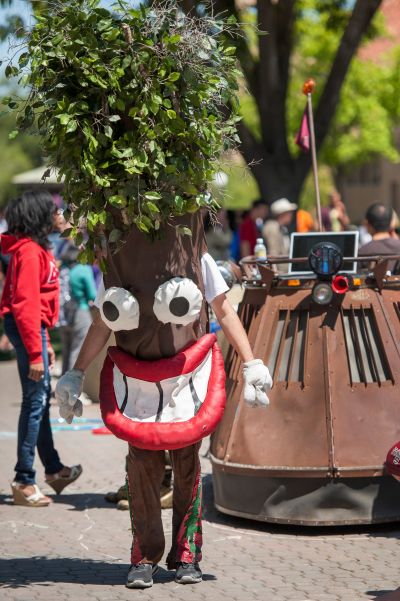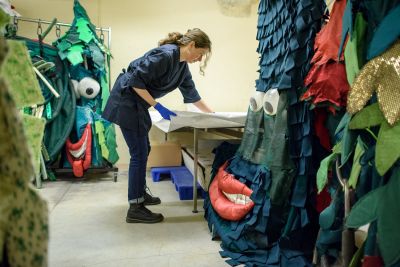In a small, climate-controlled room in the basement of Green Library, Stanford University Archives has created a nature preserve for the Stanford Trees that once skipped, twirled and leapt to the beat of the Leland Stanford Junior University Marching Band.

Jill Sison and Sarah Newton, conservation technicians who work in the Stanford Libraries Conservation Lab, visit Green Library’s collection to create custom garment bags for the Trees. (Image credit: L.A. Cicero)
Eleven Trees have already taken up residence in the room, including an evergreen of fluffy lime-green tulle, a palm with a spinning topknot of multi-colored cotton fronds, and a maple with reversible leaves of red and green satin.
The Trees hang in threesomes on rolling garment racks, each costume suspended by an ingenious system of cardboard tubes, chain link ropes and carabiners that are designed to accommodate the costumes, which vary widely in height, weight and diameter.
The Trees appear dejected without their humans, the students who sewed their leaves, needles, branches and fronds, attached their goofy faces, and hefted the towering contraptions on their shoulders.
Some of the Trees wear crumpled white bucket hats with red trim – a nod to the musicians of the Stanford Band who perform in red blazers and white bucket hats with red trim.
The Stanford Tree, which made its debut in 1975 during the Big Game against the University of California, Berkeley, is the mascot of the Stanford Band – not of the university.

Image credit: Alvaro Ponce

Image credit: Robby Beyers / Stanford Libraries Special Collections

Image credit: L.A. Cicero

Image credit: L.A. Cicero

Image credit: Courtesy Bob Siegel

Image credit: L.A. Cicero

Image credit: Courtesy Sam Weyen

Image credit: L.A. Cicero

Image credit: Courtesy Sam Weyen

Image credit: L.A. Cicero

Image credit: L.A. Cicero

Image credit: Alvaro Ponce

Image credit: L.A. Cicero

Image credit: L.A. Cicero

Image credit: L.A. Cicero

Image credit: L.A. Cicero
Students who bequeath their Trees to the university can bring them back to life at any time, checking them out of Green Library like books – say, to join other Trees performing in the halftime program in Stanford Stadium during Reunion Homecoming.
Over the last year, Daniel Hartwig, university archivist, has transported several Trees from the library to the Band Shak – home of the Stanford Band and of its Trees – and back again.
He said University Archives, which collects materials of any type that document the history of Stanford, has amassed 150,000 photographs of the Band, which can be viewed here in its online exhibit, “Incomparable: The Stanford Band.”
“If we really want to capture the history and legacy of the Band, we also have to collect the Trees, which are a central part of the Band,” Hartwig said.
A retirement home of sorts
Currently, the oldest Tree in the collection is a pear-shaped evergreen created by Judy Mischel, ’83, who accessorized the costume with four-fingered brown gloves.
The vault is also the safe house of the Tree that was kidnapped, blindfolded and held captive for two weeks the fall of 1998 by students at Cal, an event covered by newspapers far and wide. As the story goes, the Tree was returned unharmed to the Berkeley Chancellor’s office late one Friday afternoon.
“A UCPD officer immediately escorted the Tree to the Stanford Police Station, where it remains, under armed guard, in the evidence room,” the Stanford Daily reported the following Monday. “The costume’s owner and wearer, Chris Henderson, will reclaim the Tree in time for Tuesday’s women’s volleyball game.”
While Stanford has created a sanctuary for retired Trees, the university is not cleaning or repairing the one-of-a-kind costumes. For some Trees, the library will be their “forever home,” because they are too fragile or damaged to relive their glory days. Some are missing key features, such as their internal frames, which students recycled in later Trees.
First Tree, much repaired, lives on
The Band proposed a “tree theme” on a lark in 1975, four years after the Stanford “Indians” became the “Cardinal” – the color, not the bird – leaving the university without a mascot.
During the Big Game program that year, the Band adopted a tree theme for the halftime program. A “tree queen” was carried in on a wooden platform, surrounded by flower-tossing “wood nymphs” and accompanied by the first Tree, Christina “Chris” Hutson, an undergraduate biology major.
Hutson and a friend had stayed up all night creating the costume – using a bed sheet, a hula hoop, a large chunk of wood wedged into a scuba backpack and a 2-foot-tall Styrofoam cone. The first Tree was covered in construction paper leaves – red in deference to the towering redwood on the university seal.
“It was supposed to be a spoof on mascots, not the real thing,” two former Band members told Stanford magazine in the 2000 article, “ Hey, At Least It’s Not a Chicken.”
But the Tree proved popular, and the mascot was born.
Hutson, who later spray-painted the costume green, continued performing as the Tree the following year while earning a master’s degree in biology. That was the year that “Oski,” the Cal Bears’ mascot, tackled her.
“The Band broke formation – though I’m not sure they were ever in formation – and came to pull the bear off me,” she said. “The bear was pulling off my leaves. The Band got me back on my feet and I danced some more.”
Despite the bear attack, Hutson became a veterinarian (small animals).
Hutson bequeathed the costume to Bob Siegel, a conga player in the Band, who served as the Tree during the 1977-78 academic year and is now a professor (teaching) of microbiology and immunology at Stanford Medicine. Over the decades, Siegel tended the Tree, adding new leaves of paper and felt.
“There were lots of other jerry-rigged repairs and additions as the Tree progressively fell apart,” said Siegel, who still slips into the costume a couple times a year for campus events.
Custom garment bags, oral histories
In coming weeks, Sarah Newton and Jill Sison, conservation technicians who work in the Stanford Libraries Conservation Lab, will create custom garment bags for the Trees, using a synthetic fabric that museums use to protect treasures during shipping and storage.
They recently brought some of the tools of their trade – including a portable sewing machine, polyester thread and 50 yards of white fabric – to Green Library, where they will design and sew the garment bags.
“The Trees, which are among the largest items I’ve housed, are too large for any box-type enclosures,” Newton said. “The students used different materials and construction methods, so there is nothing very predictable about the size, shape and design of the costumes. Each one is an individual.”
The final step in the Tree conservation project will be an oral history. And who better to conduct those interviews than a former Tree?
Sam Weyen, ’18, whose debonair palm – blue eyes, gold monocle, black mustache, iridescent fronds – performed during the 2016-17 academic year, said he is looking forward to meeting his predecessors.
“Everything that followed that first Tree, which began as a joke, arose chaotically and organically,” he said. “It wasn’t until 2016 that we finally had a complete list of every person who’s ever donned the leafy crown. I’m excited to learn just how the red paper costume that Chris Hutson wore on the field in 1975 evolved into the beloved, bemusing and bewildering tradition it is today as I get to know the people who led the transformation.”